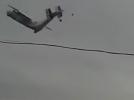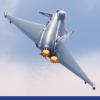Jazz DH8C at Gaspe on Sep 10th 2012, hard landing and tailstrike
A Jazz de Havilland Dash 8-300, registration C-GUON performing flight QK-8721 from Iles De La Madeleine,QC to Gaspe,QC (Canada) with 32 passengers and 3 crew, landed on Gaspe's runway 29, touched down hard 109 feet past the runway threshold experiencing a vertical acceleration of +3.4G and struck its tail onto the runway surface. The aircraft rolled out without further incident and taxied to the apron, where the passengers disembarked normally. There were no injuries, the aircraft received substantial structural damage.
Canada's Transportation Safety Board (TSB) released their final report concluding the probable causes of the accident was:
Findings as to causes and contributing factors
- The application of a pronounced nose-up control to reduce the rate of descent resulted in a nose-high attitude. This attitude, combined with a hard landing that compressed the oleos, resulted in the aft part of the fuselage striking the runway, causing significant damage to the aircraft structure.
- The pilot monitoring was focusing attention outside and did not identify the loss of energy in time to notify the pilot flying or to intervene and thereby prevent the hard landing.
- The aircraft crossed the runway threshold with insufficient energy to stop the rate of descent with only an increase in the nose-up attitude at the time of the flare.
- The crew had not received training on the technique recommended by the manufacturer in the event of a higher than normal rate of descent near the ground. As a result, the pilot flying did not limit the nose-up attitude or increase power to reduce the rate of descent, and the aircraft fuselage struck the runway.
Findings as to risk
- If pilots descend below the optimum approach slope of 3°, there is an increased risk of collision with obstacles during the approach and of landing short of the runway.
- If pilots follow the DH8C SOP precisely when executing a short field landing, the aircraft will pass the threshold of the runway in a low energy state, and be at risk of a hard landing or a hard landing with an aft fuselage strike.
- If pilots adapt the DH8C short field landing SOP to avoid a steep approach in a low energy state by aiming to land close to the threshold while on the usual 3° slope, they are at risk of landing short of the runway.
- If crews do not possess adequate knowledge of the limits of the different visual glideslope indicators, they may continue to follow visual guidance that does not guarantee sufficient clearance above the threshold, increasing the risk of landing short of the runway.
- If pilots do not have direct access to eye-to-wheel height data, they may continue to perform approaches with a visual glideslope indicator that is not appropriate for the type of aircraft flown, increasing the risk of crossing the runway threshold with a reduced safety margin.
- If cockpit voice recordings are not available to an investigation, this may preclude the identification and communication of safety deficiencies to advance transportation safety.
- If stabilized approach criteria do not specify an acceptable speed range, there may be confusion during a critical stage of the flight, increasing the risk of an approach and landing accident.
Other findings
- The use of image (video) recording systems that would include imaging within the cockpit would increase transportation safety by providing investigators with a reliable and objective means of determining what happened.
While enroute at 14,000 feet the crew received clearance for a contact approach to Gaspe's runway 29, the crew subsequently initiated the descent and approach to Gaspe. The first officer (ATPL, 4,500 hours total) was pilot flying, the captain (ATPL, 11,700 hours total) was pilot monitoring. The aircraft intercepted final approach about 5.5nm before touchdown at 2400 feet above aerodrome level (AAL) and 138 KIAS. The aircraft subsequently descended to an optimal 3 degrees glidepath and continued to descend below the glide path until at about 170 feet AAL all 4 PAPIs indicated red. The pilot flying reduced power, the rate of descent increased even more, at 70 feet AAL, about 700 feet short of the runway threshold, the power was reduced to idle, the airspeed reduced to Vref+3. Tyre marks indicate the aircraft touched down first 109 feet past the runway threshold, the tail contacted the runway surface. The aircraft rolled out, backtracked the runway and taxied to the apron.
The crew inspected the damage and reported their observations to dispatch. As a precaution passengers, who felt pain at the moment of impact, were asked whether they would like medical examination, 8 passengers went to see the doctor but all returned to continue their flight with a later aircraft.
The TSB analysed that the aircraft reached the upper limit of the PAPIs (all 4 lights white) about 3.5nm before the runway threshold at 1300 feet AAL and 130 KIAS, about 1.5nm before the runway threshold at 500 feet AAL the aircraft reached the optimum glidepath at 119 KIAS (Vref+16). The aircraft continued to descend below the glidepath until reaching the lower limit of the PAPIs (all 4 lights red) 0.5nm before the runway threshold at 170 feet AAL and 115 KIAS. At 45 feet AAL the power reduction began, the aircraft was 700 feet before the runway threshold at 106 KIAS (Vref+3). The aircraft crossed the runway threshold at 100 KIAS (Vref-3), the aircraft pitched up to 5 degrees nose up. The aircraft touched down hard at 98 KIAS, 0.03 seconds after the main wheels touched down the tail contacted the runway surface when the pitch increased through 7 degrees nose up, the aircraft experienced a vertical acceleration of +3.4G.
The TSB analysed: "The approach and landing occurred in visual meteorological conditions, and there is no indication that they were a factor in this occurrence. All of the aircraft's systems were operating normally."
The TSB analysed: "During the occurrence flight, the crew was not using the SOP short-field landing procedure, nor was the landing in CYGP considered as requiring this procedure. The occurrence approach was performed in the normal landing configuration (flaps 15), with a descent below the 3° descent path using an aiming point closer to the threshold."
With regards to cockpit resource management as well as the lack of response by the captain the TSB analysed:
"Effective crew resource management requires that pilots agree on a common plan for the approach and landing, and generally the approach briefing serves this purpose. Given the lack of CVR data, it was not possible to evaluate the interaction between crew members during the approach.
The PF was focusing attention outside to land on the aiming point and did not notice the aircraft’s energy deficit. During this time, the PM was also concentrating outside and did not detect the reduction in energy on short final approach in time to react.
The pilot-in-command had never had to intervene by taking the controls during co-pilot landings. The co-pilot had considerable flight experience and had shown full command of the aircraft during flights the day before. These positive experiences could have influenced the level of alertness and, consequently, the reaction time of the pilot-in-command in the role of PM."
The marks on the runway (Photo: TSB):
The damage (Photo: TSB):
http://avherald.com/h?article=4787762e














Komentarze